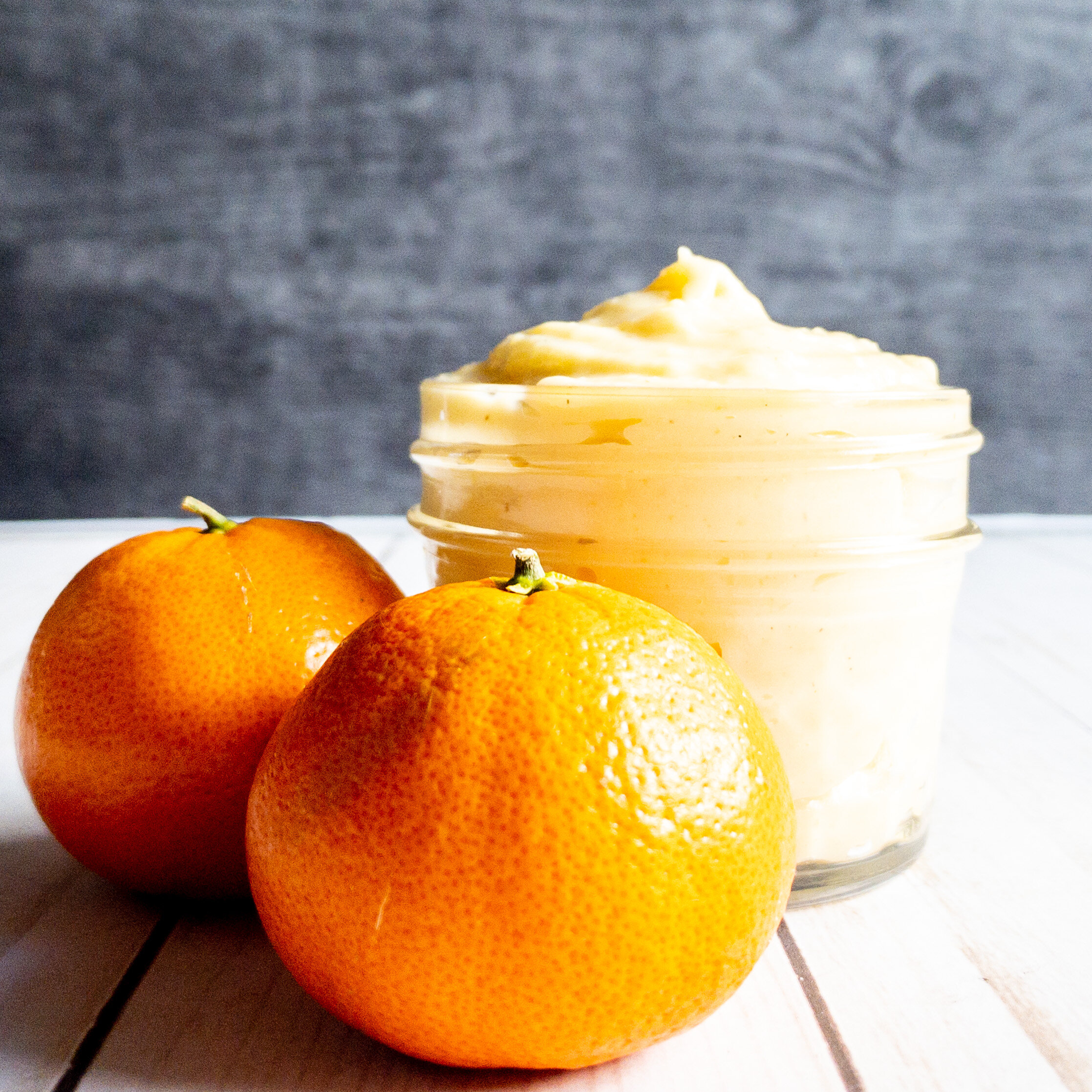Clementine Creme Patisserie (Pastry Cream)
Sweet and citrusy, this clementine creme patisserie (or pastry cream) is versatile as a filling for pies, cakes, pastries, trifles, and mini desserts.
This post may contain affiliate links from which, at no additional cost to you, I may earn a small commission to keep this site running. Only products I myself would or do use are recommended.
The story
Ennui: a feeling of listlessness and dissatisfaction arising from a lack of occupation or excitement.
There’s a weird cycle to quarantine that includes a mix of ennui and FOMO. I’m bored and listless. I have things to do for work but little motivation (given that I’d have to find a way to grade or lesson plan while my toddler naps instead of showering). Then ideas start coming to me in abundance. Like a dozen uses for one ingredient I’m trying to use up. But I have so many ideas I can’t decide, partly because of that sense of ennui, partly because of a weird form of FOMO—fear of missing out on the best baking project, fear I’ll pick one that’s just okay and regret wasting precious ingredients on it.
That’s when I take a breath. I remind myself this will end. I keep adding to my long, long list of baking ideas and remind myself I will try each one at some point—but I can’t try them all at once and that’s okay.
Which I’m now realizing may not be a problem many of you can relate to. But it’s where I’m at. Ennui mixed with FOMO. About a lot of things.
I have plenty of things I should be doing. But not enough things I want to be doing. And not enough motivation beyond doing what I must, like teaching from home.
Life in the time of quarantine, y’all.
Anyway, this recipe. I did not expect to like it so much. I honesty just wanted to use up the Cuties my daughter—in true toddler fashion—couldn’t get enough of for a week straight and now will chew then hand back to me saying, “All done.” Thanks, kid.
So I thought it would be so punny to make a Cutie pie. I honestly could have made any sort of fruit/citrus pie and used the juiced Cuties and been fine. But no. I had to get fancy. Make some curd, make some pastry cream, layer it all together. And obviously I had to make a small batch since I can’t share my baking with anyone these days.
Or can I? Maybe I’ll become like Santa, only I’ll leave desserts on people’s doorsteps. Hmmm 🤔
Anyway, I’ve been meaning to try pastry cream (or creme patisserie in French) again after my lemon version last summer was a soupy mess. Delicious, but not suitable for anything but a sauce. I suppose it was closer to creme anglaise at that point. Oops. So I tried it again with clementine peel, adding a couple tablespoons of juice at the end (partly because I’d thickened it too much), and wow. This was really good. Like, I kept having to get a new spatula because I kept trying it as I spooned it into jars.
Tips for this recipe
Whisk egg like your life depends on it
Confession: I scrambled some of the egg while tempering. 🤦♀️ I think it was because I used a teeny tiny mini whisk that was barely taller than the mixing bowl I used. It was really hard to pour and whisk at the same time. So whisk quickly and constantly, but also choose sizes wisely and be willing to dirty another utensil if you realize you’ve chosen mismatching sizes.
Flour and cornstarch work the same
Most recipes call for cornstarch, because it’s a more reliable thickener and less likely to leave a noticeable taste. However, flour works just as well, though the cook time may be slightly different. If you’re like me and #bakinginthetimeofcorona, you use what you have.
Don’t burn the milk
Obviously, you shouldn’t burn milk unless that’s part of the recipe (and then it’s called scalding). This is not a scalded milk recipe, as scalding could cause bitterness from the orange peel to leach into the milk. Also, scalding could scramble the eggs and will very likely give your pastry cream a burnt taste.
Zesting the clementines may leave pieces in your final cream
I like peeling citrus with a potato peeler when steeping it in milk. It’s what I do in my dark chocolate orange sauce. It allows you to strain all of the peel out so you don’t have little bits in your finished product. While that may be fine in a sauce, it’s less desirable in a pastry cream.
The splash of juice at the end is key
Sure, you could add more zest or peel to the milk, but peeling a tiny little clementine gets old real fast. So I called it quits to see if I had enough. I did. Much more and you risk bitterness leaching in from the peel/any pith that came with it. Plus, stirring in the juice after the pastry cream is cooked serves two purposes: smoothing your final product and adding a bright citrus flavor.
Don’t add any juice until the end
Along with my last tip, you can only add juice at the end, after it’s all cooked and come together. Cooking citrus juice is precarious, because it can lose its flavor and take on a burnt taste. But most importantly, it can curdle the milk. It’s why you only add zest or peel to the milk. The two don’t play nice without a buffer like the eggs and flour. Remember: milk and lemon juice create buttermilk.
Clementine Creme Patisserie (Pastry Cream)
- cook/prep time: 30 minutes
- cool time: 1-2 hours
- total time: 2 hours, 30 minutes
Yields: about 1.5-2 cups
Ingredients:
- 2 cups whole milk
- peel or zest from 3-4 clementines or mandarin oranges
- 4 egg yolks (or 2 yolks and 1 egg, but there’s a high risk of a lumpy cream)
- ¼ cup flour or cornstarch
- ½ cup sugar
- pinch sea salt
- 2-4 tablespoons juice from the zested oranges
Instructions:
- Using a potato peeler, peel just the zest from 3-4 clementine or mandarin oranges. Alternatively, you could zest the oranges, but you will need to double strain it to remove all the zest. Add zest and milk to a small saucepan and cook over medium heat, stirring frequently with a rubber spatula and scraping sides and bottom to prevent the milk from burning. Heat until steam comes off the milk and it just starts to bubble slightly. Remove from heat and let steep for 10 minutes or until it comes to room temperature.
- While milk is cooling, whisk flour, sugar, and salt in a small to medium mixing bowl (make sure its large enough that you can whisk the milk into it quickly without it spilling out). Add egg yolks and whisk until combined. It may be thick and pasty, which is okay. You just want the flour mixed in at this point to prevent lumps.
- Strain milk by setting a fine mesh sieve over a bowl and pouring milk/zest through it. Return milk to saucepan. Heat over medium-low until steaming once again. While whisking, very very slowly pour a small amount of milk into the egg mixture. Whisk vigorously to combine and prevent scrambling the egg. Continue whisking and adding milk until all of it is combined.
- Pour mixture back into the saucepan and cook over medium-low heat until thickened to a pudding texture,whisking constantly and getting to the corners and sides to prevent burning or clumping. It will only thicken a tiny bit while cooling, so cook it to your desired consistency, about 5-10 minutes.
- Remove from heat and stir about 30 seconds to cool slightly. Add clementine juice, 1 tablespoon at a time, whisking well after each addition, until desired flavor and consistency are reached. Don’t add too much or it will be too loose. About 4 tablespoons was perfect for me.
- Strain through a medium to large fine mesh sieve set over a bowl. This will take some elbow grease as you need to stir/press it against the sieve to force it through. Straining is optional but recommended to remove any lumps or scrambled egg pieces. Once strained, place a piece of plastic wrap directly on the surface and refrigerate until cool, about 1-2 hours.
Store in an airtight container in the refrigerator. It will last about a week in the fridge.
Enjoy!








